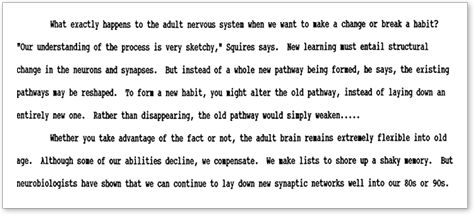
Because it is laid out in columns, this site doesn't display properly on a phone held vertically.
Please turn it sideways.

Because it is laid out in columns, this site doesn't display properly on a phone held vertically.
Please turn it sideways.
Before you accept scientific evidence about design, check out what they tested.

Before you accept scientific evidence about design, check out what they tested.
There’s quite a lot of experimental research published on typography and information design. But you shouldn’t accept the results uncritically, and certainly not by just reading the abstract, or quoting someone else’s summary of the findings. Look carefully at the materials, the participants and the tasks they used.
For example, in 1998 a research team1 published a study of justified type (they found no difference between justified and ranged-left). But when you look at the materials they tested, you wonder whether their findings are valid for fonts we have available today. They used a narrow computer output font with fixed character widths (check out the squashed ‘m’ and ‘w’).

In 1998 when this was published, laser printers with decent fonts had been in common use for several years, so they didn’t have to use obsolete printing technology for their materials. Did they not notice there was something better? Detail matters so it means we can’t take it as read that their results apply to decent professional fonts.
Here’s another one from a 1986 study2 which used a daisywheel printer which could only justify lines by increasing just some of the word spaces on a line. So spaces were uneven within the line as well as between lines. This study is simply not relevant to today’s technology yet you still see it cited from time time.

At least these two research teams show what they researched. Many older studies of legibility fail to show any of their materials and some even fail to name the typefaces they researched.
Quite recently, research on icons in consumer contracts was reported3 with illustrations of the materials. But it emerged that the designer of their research report had reformatted them for publication. So what was reported was not the same as what was researched.
Karel van der Waarde and Myra Thiessen recently published a great paper that helps anyone to evaluate typographic research.4 Take a look before you accept research findings you read about.
1. Joan H. Coll, Jerry Fjermestad and Richard Coll (1998) An eight experiment sequence to determine reading equality, Information & Management
Volume 34, Issue 4, 231-242
2. Trollip, S. R., & Sales, G. (1986). Readability of Computer-Generated Fill-Justified Text. Human Factors, 28(2), 159-163.
3. Rob Waller (2020) Improved but nowhere near OK, Simplification Centre blog, 15/3/20
4. van der Waarde, K., & Thiessen, M. (2025). Nineteen questions to evaluate typographic research: Chaff and wheat. Visible Language, 59(1), 77–99.